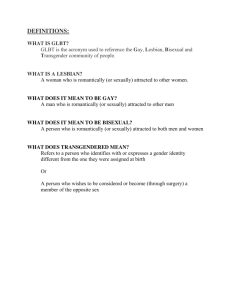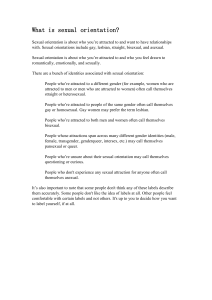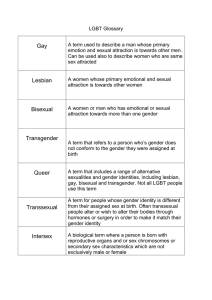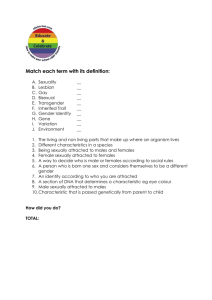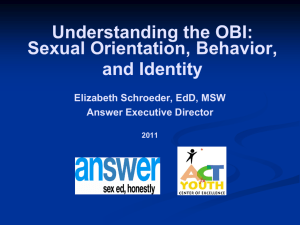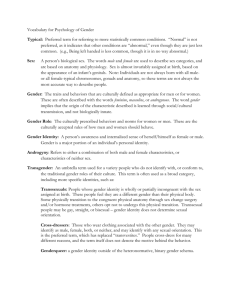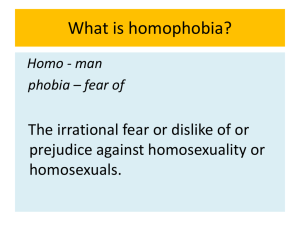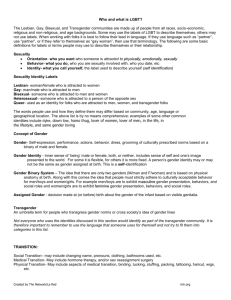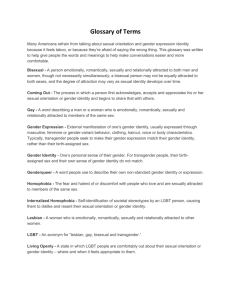Terms and Definitions
advertisement
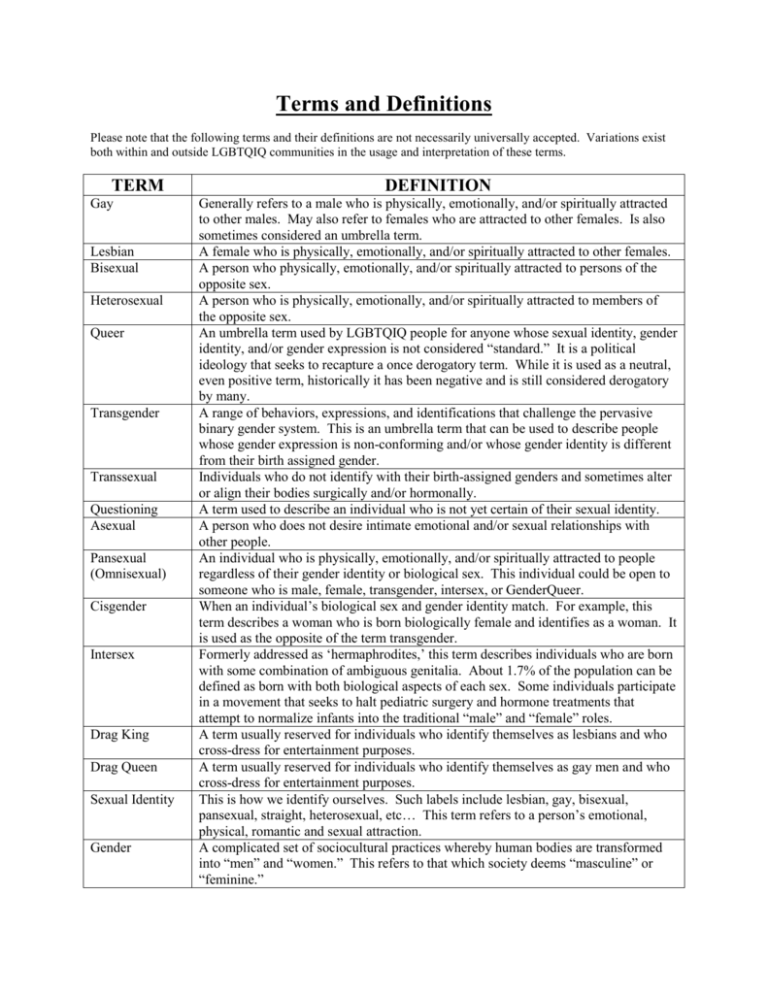
Terms and Definitions Please note that the following terms and their definitions are not necessarily universally accepted. Variations exist both within and outside LGBTQIQ communities in the usage and interpretation of these terms. TERM Gay Lesbian Bisexual Heterosexual Queer Transgender Transsexual Questioning Asexual Pansexual (Omnisexual) Cisgender Intersex Drag King Drag Queen Sexual Identity Gender DEFINITION Generally refers to a male who is physically, emotionally, and/or spiritually attracted to other males. May also refer to females who are attracted to other females. Is also sometimes considered an umbrella term. A female who is physically, emotionally, and/or spiritually attracted to other females. A person who physically, emotionally, and/or spiritually attracted to persons of the opposite sex. A person who is physically, emotionally, and/or spiritually attracted to members of the opposite sex. An umbrella term used by LGBTQIQ people for anyone whose sexual identity, gender identity, and/or gender expression is not considered “standard.” It is a political ideology that seeks to recapture a once derogatory term. While it is used as a neutral, even positive term, historically it has been negative and is still considered derogatory by many. A range of behaviors, expressions, and identifications that challenge the pervasive binary gender system. This is an umbrella term that can be used to describe people whose gender expression is non-conforming and/or whose gender identity is different from their birth assigned gender. Individuals who do not identify with their birth-assigned genders and sometimes alter or align their bodies surgically and/or hormonally. A term used to describe an individual who is not yet certain of their sexual identity. A person who does not desire intimate emotional and/or sexual relationships with other people. An individual who is physically, emotionally, and/or spiritually attracted to people regardless of their gender identity or biological sex. This individual could be open to someone who is male, female, transgender, intersex, or GenderQueer. When an individual‟s biological sex and gender identity match. For example, this term describes a woman who is born biologically female and identifies as a woman. It is used as the opposite of the term transgender. Formerly addressed as „hermaphrodites,‟ this term describes individuals who are born with some combination of ambiguous genitalia. About 1.7% of the population can be defined as born with both biological aspects of each sex. Some individuals participate in a movement that seeks to halt pediatric surgery and hormone treatments that attempt to normalize infants into the traditional “male” and “female” roles. A term usually reserved for individuals who identify themselves as lesbians and who cross-dress for entertainment purposes. A term usually reserved for individuals who identify themselves as gay men and who cross-dress for entertainment purposes. This is how we identify ourselves. Such labels include lesbian, gay, bisexual, pansexual, straight, heterosexual, etc… This term refers to a person‟s emotional, physical, romantic and sexual attraction. A complicated set of sociocultural practices whereby human bodies are transformed into “men” and “women.” This refers to that which society deems “masculine” or “feminine.” Gender Expression Gender Identity Sex Cross Dresser GenderQueer Two Spirit Gender confirming efforts Closeted Coming Out Outing Someone Down Low Stonewall Riots Homophobia Heterosexism Hate Crime This refers to an individual‟s characteristics and behaviors such as appearance, dress, mannerisms, speech patterns, and social interactions that are perceived as masculine or feminine. This is the individual‟s internal, deeply felt sense of being male, female, or something other or in-between. This is our “packaging” and is determined by our chromosomes (XX for females and XY for males; and our external and internal genitalia.) About 1.7% of the population can be defined as born with both biological aspects of both sexes. An individual who dresses in clothing that is culturally associated with member of the “other” sex. Most of these individuals are heterosexual and participate in this activity on a part-time basis. Individuals who use this term are united by their rejection of the notion that there are only two genders. It is an evolving concept. Some believe they are a little of both or feel they have no gender at all. Others believe that gender is a social construct and choose not to adhere to that construct. Some individuals fit into the stereotypical gender roles of their sex, but still reject gender as a social construct. A term used to describe Native Americans who fulfill one of many mixed gender roles. This term usually implies a masculine spirit and a feminine spirit living in the same body. This term is replacing sex reassignment surgery (SRS) and covers the full range of measures individuals may select to confirm their gender identity. This term takes into account the number of procedures associated with transitioning, including genital surgery, breast augmentation or reduction, hysterectomy and hormone therapy. The opposite of being “out,” meaning that one‟s sexual identity is concealed or presumed to be heterosexual. Generally, denotes the act of telling someone that one is lesbian, gay, bisexual, transgender or another sexual identity. To declare someone‟s sexual identity publicly without their permission. A label adopted by some African Americans to describe men who seek same sex relations buy do not necessarily identify as gay or bisexual. On June 28, 1969, New York City police attempted a routine raid of a working-class gay and lesbian bar in Greenwich Village. Unexpectedly, the patrons, resisted, and the incident escalated into a riot that continued for several days. Most people look at this event as beginning the American Gay Liberation movement and all subsequent LGBTQIQ movements. The irrational fear and hatred of all those individuals who transgress, violate, or blur the dominant gender categories in a given society. These attitudes lead to massive discrimination and oppression against the trans, drag, and intersex communities. The discriminatory assumption that people are or should be attracted to the people of the other sex. This assumption circulates anit-gay attitudes by promoting a value system and stereotypes that appear to justify prejudice and discrimination. Any criminal act in which the targeted individual is chosen simply because of his or her affiliation with a minority group. In some states, these carry an additional penalty beyond the standard penalty for assault, murder, etc…
